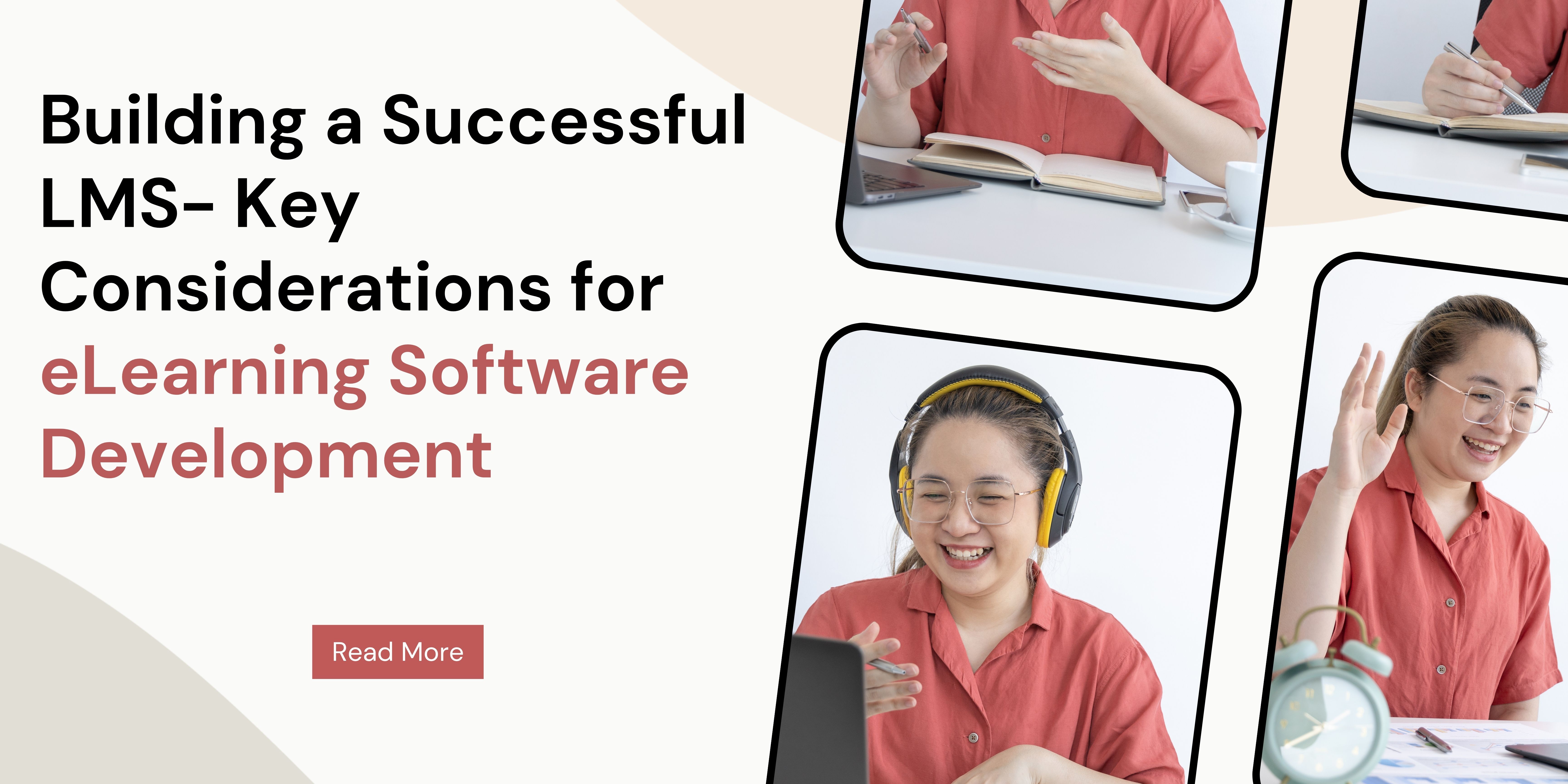Blog Software Development
Building a Successful LMS: Key Considerations for eLearning Software Development

Introduction: Why a Well-Designed LMS is the Cornerstone of Effective eLearning
In the modern era of rapid advancements, eLearning has emerged as a crucial instrument for acquiring knowledge and honing skills. However, merely uploading content onto the internet is insufficient. To fully harness the power of eLearning, a robust foundation is essential – a meticulously crafted Learning Management System (LMS).
This introduction delves into the critical role that an LMS plays in creating effective eLearning experiences. We'll explore how custom LMS development solutions can help customers close training gaps, boost productivity, and increase educational outreach.
-
Enhance Engagement: Move beyond static content with interactive features, gamification elements, and personalized learning paths.
-
Optimize Learning Outcomes: Track learner progress, assess knowledge retention, and identify areas for improvement.
-
Streamline Administration: Manage user access, assign courses, and generate reports with ease.
-
Boost Scalability: Cater to a growing number of learners and diverse learning needs effortlessly.
Identifying Your Target Audience and Their Needs in eLearning
Before venturing into the exciting world of eLearning development, understanding your target audience is paramount. Just like building a bridge requires knowing who will be crossing it, crafting an effective eLearning program hinges on identifying the specific needs and characteristics of your learners.
This section will equip you with the tools to pinpoint your target audience and tailor your eLearning experience accordingly.
Who are you trying to reach?
Here are some key aspects to consider:
-
Demographics: Age, location, education level, technical skills.
-
Job Roles & Responsibilities: Understanding their daily tasks and challenges helps you create relevant content that bridges knowledge gaps.
-
Learning Goals & Objectives: What do they hope to achieve by completing the eLearning program? Are they seeking new skills, compliance training, or professional development?
-
Learning Styles: Do they prefer visual aids, interactive exercises, or traditional text-based learning?
Unveiling Needs Through Research:
Once you have a broad understanding of your target audience, delve deeper to uncover their specific needs. Here are some effective research methods:
-
Stakeholder Interviews: Consult with managers, trainers, or subject matter experts to gain insights into learning gaps and desired outcomes.
-
Surveys and Questionnaires: Gather valuable data directly from your target audience about their preferred learning format, existing knowledge level, and pain points.
-
Competitor Analysis: Review existing eLearning programs in your niche to identify best practices and potential gaps that your program can address.
Building the Bridge to Success:
By understanding your target audience and their needs, you can build an eLearning program that truly resonates. Here's how:
-
Content Tailoring: Craft content that is relevant to their job roles and directly addresses their learning goals.
-
Delivery Method Selection: Choose the format (video lectures, simulations, quizzes) that best suits their learning styles and preferences.
-
Engagement Strategies: Incorporate interactive elements, gamification, and personalized learning paths to keep them motivated and engaged.
Remember, a well-defined target audience is the first step towards building a successful eLearning program. By investing time in understanding their needs, you can create a bridge that leads them to their learning objectives.
Designing a User-Centric Interface and Navigational Structure for Seamless Learning Experience
Within the realm of eLearning, a user-focused interface and navigational layout serve as the foundation for a smooth learning experience. Similar to a user-friendly map leading us through an unfamiliar city, a thoughtfully designed interface enables learners to easily explore the educational material. Here are the key steps to creating this crucial user experience:
Understanding the User:
-
Empathy is Key: Begin by putting yourself in the learner's shoes. What are their expectations? What might cause confusion or frustration?
-
Prioritize Learnability: Design an interface that is intuitive and easy to grasp. Minimize the learning curve and prioritize ease of use.
Crafting a User-Centric Interface:
-
Clean and Uncluttered: Strive for a minimalist aesthetic. Use clear visuals, well-organized layouts, and consistent design elements.
-
Accessibility Matters: Ensure your interface is accessible to learners with disabilities. Incorporate features like screen reader compatibility and adjustable font sizes.
-
Intuitive Interaction: Make interactions predictable and logical. Buttons and icons should be self-explanatory, minimizing the need for extensive tutorials.
-
Responsive Design: The interface should adapt seamlessly across different devices (desktop, mobile, tablets) for a consistent learning experience.
Building a Seamless Navigation Structure:
-
Logical Hierarchy: Organize content in a clear and logical hierarchy. Utilize categories, subcategories, and breadcrumbs for easy navigation.
-
Search Functionality: Include a powerful search bar for learners who prefer to jump directly to specific topics.
-
Progress Tracking: Visually represent learner progress through progress bars, badges, or completion indicators. This keeps them motivated and engaged.
-
Course Map: Provide a visual overview of the entire course, allowing learners to see the bigger picture and plan their learning journey.
-
Contextual Help: Offer subtle hints and on-demand help within the course itself.
Testing and Refinement:
Usability testing with real learners is crucial. Observe their interactions and gather feedback to identify areas for improvement.
By following these principles, you can create a user-centric interface and navigational structure that fosters a seamless learning experience, keeping learners engaged and motivated throughout their journey.
Must Read: Top 10 Ecommerce Development Companies in the USA (2024)
Choosing the Right Features and Functionality for Your Customized LMS Solution
In the realm of eLearning, a one-size-fits-all approach rarely yields optimal results. This is where Customized Learning Management Systems (LMS) come into play. By selecting the right features and functionalities, you can tailor your LMS to perfectly match your unique learning goals and target audience.
But with a vast array of features available, navigating the selection process can feel overwhelming. Here's a roadmap to guide you in choosing the functionalities that will empower your customized LMS:
1. Identifying Your Needs:
-
Learning Objectives
-
Target Audience
-
Content Delivery
2. Prioritizing Core Functionalities:
-
Content Management
-
User Management
-
Assessment & Evaluation
-
Reporting & Analytics
3. Considering Additional Features:
-
Gamification
-
Collaboration Tools
-
Social Learning
-
Mobile Learning
-
Customization Options
4. Prioritization and Integration:
Don't overwhelm your learners with every available feature. Carefully prioritize functionalities based on your specific needs and ensure seamless integration between them.
5. Scalability and Future Needs:
Consider your future learning goals and choose an LMS that can scale up to accommodate a growing number of learners and evolving training requirements.
By following these steps and carefully considering your unique needs, you can select the right features and functionalities to create a customized LMS that fosters a truly engaging and effective learning experience.
LMS feature selection, essential features for eLearning platforms, custom LMS development, scalable learning management system
Learning Management Systems (LMS) are the cornerstones of successful eLearning initiatives. But with a plethora of features available, choosing the right ones can feel daunting. This guide explores essential features, custom LMS development, and scalability to empower you to build the perfect eLearning platform.
Essential Features for any LMS:
-
Content Management: Seamless uploading, organization, and delivery of diverse learning materials (videos, documents, quizzes). Look for SCORM compliance for easy integration of existing content.
-
User Management: Efficient user enrollment, role-based access control (admins, instructors, learners), and progress tracking are fundamental.
-
Assessment & Evaluation: Create a variety of assessments (quizzes, assignments) to gauge learner understanding and track performance effectively.
-
Reporting & Analytics: Gain valuable insights into learner progress, identify knowledge gaps, and measure the overall effectiveness of your training programs.
Safeguarding Your Learning Journey: Data Security and Compliance in eLearning Software Development
Nowdays, data security and regulatory compliance are paramount concerns in eLearning software development. Learners entrust sensitive information to your platform, and ensuring its protection fosters trust and builds a secure learning environment. Here's how to integrate robust data security and compliance measures into your eLearning software development process:
Prioritizing Data Security:
-
Encryption: Implement robust encryption protocols for data transmission (in transit) and storage (at rest). This scrambles data, making it unreadable in case of a breach.
-
Authentication & Access Control: Enforce strong authentication measures (multi-factor authentication) and implement granular access control to prevent unauthorized access to learner data.
-
Regular Security Audits: Conduct regular security audits to identify and address vulnerabilities in your eLearning software.
-
Incident Response Plan: Develop a comprehensive plan for responding to security incidents, minimizing damage and ensuring swift recovery.
Adhering to Regulations:
-
Identify Applicable Regulations: Depending on your location and target audience, various data protection regulations may apply (e.g., GDPR, FERPA, HIPAA). Familiarize yourself with these regulations and ensure your eLearning software complies with their data privacy and security requirements.
-
Transparency & User Control: Provide learners with clear and transparent information about how their data is collected, used, and stored. Offer them control over their data, allowing them to access, rectify, or erase their information upon request.
-
Data Minimization: Collect only the data essential for delivering the learning experience. Avoid collecting unnecessary personal information from learners.
Integration Throughout Development:
-
Security by Design: Embed data security and compliance considerations into every stage of the eLearning software development lifecycle, from planning and design to implementation and maintenance.
-
Secure Coding Practices: Developers should adhere to secure coding practices to minimize vulnerabilities that could be exploited by attackers.
-
Regular Security Testing: Incorporate regular security testing throughout development to identify and address potential security flaws proactively.
Building Trust and Confidence:
By prioritizing data security and regulatory compliance, you demonstrate your commitment to protecting learner privacy. This fosters trust and confidence, creating a safe and secure learning environment that empowers learners to focus on their development goals. Remember, data security and compliance aren't one-time tasks. They are ongoing processes that require continuous vigilance and adaptation to evolving threats and regulations.
Additional Considerations:
-
User Education: Train learners on cybersecurity best practices, such as creating strong passwords and being cautious about phishing attempts.
-
Vendor Management: If you're using third-party services or hiring an eLearning software development company for your eLearning platform, ensure that their data security practices are aligned with your own.
Conclusion: Building a Successful LMS – A Win for Learners and Educators
The journey of building a successful LMS isn't just about technology – it's about empowering both learners and educators. By carefully considering your target audience, prioritizing user experience, and implementing robust features, you can create a platform that fosters a dynamic and engaging learning environment.
Recap: The Pillars of a Successful LMS:
-
Understanding Your Audience: Tailor content and functionalities to their specific needs and learning styles.
-
User-Centric Design: Create a clean, intuitive interface and a navigational structure that makes learning effortless.
-
Feature Selection: Choose the right features to achieve your learning goals – from core functionalities like content management and assessment to engaging elements like gamification and social learning.
-
Data Security & Compliance: Safeguard learner information with robust security measures and ensure compliance with relevant data protection regulations.
The Benefits for Learners:
-
Engaging Learning Experiences: Interactive content, gamification, and personalized learning paths keep them motivated and actively involved.
-
Accessibility and Flexibility: Mobile-friendly platforms allow for on-the-go learning, catering to busy schedules.
-
Clear Learning Objectives: Well-defined courses and progress tracking empower learners to monitor their growth and stay focused.
The Benefits for Educators:
-
Streamlined Course Management: Easily upload, organize, and deliver learning materials with efficient user management tools.
-
Effective Assessment & Evaluation: Track learner progress, identify knowledge gaps, and adapt instruction accordingly.
-
Data-Driven Insights: Gain valuable data through reporting and analytics to measure the effectiveness of training programs and make informed decisions.
Building a Bridge to Success:
A well-designed LMS acts as a bridge, connecting learners with the knowledge and skills they need for success. It empowers educators with the tools to deliver engaging and effective instruction. By following the principles outlined in this guide, you can embark on building a successful LMS that fosters a thriving learning ecosystem for everyone involved.



